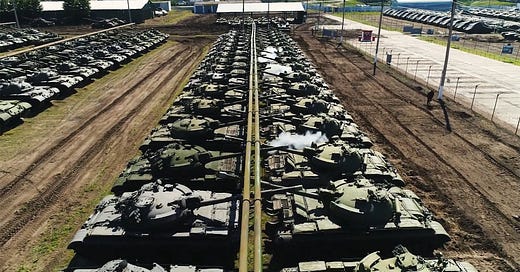In recent weeks, Russian President Vladimir Putin has outlined the Kremlin’s negotiation proposal. He has proposed conducting strategic arms and space negotiations in exchange for pausing the fighting in Ukraine. The nuclear blackmail toward the United States and its allies is a part of this framework. Other Russian officials and experts loyal to the Kremlin are playing good cop/bad cop in outlining these negotiations. The harsher officials insist on the capitulation of Ukraine, while the softer ones are promoting a so-called “Korean Scenario.” The latter describes a ceasefire–or at least decreasing the intensity of warfare–and keeping all the occupied territories in Russian hands. One possible explanation for why the Kremlin is pushing the “Korean Scenario” is a consistent exhaustion of the arms storage bases that Russia inherited from the Soviet Union. This exhaustion is still in process, but Russia may lose its offensive potential by 2025 as these stores are used up (Kremlin.ru, February 20; Globalaffairs.ru, February 23; Kremlin.ru, February 29; Kremlin.ru, March 1; T.me/Medvedev_telegram, March 14).
Soviet-era arms storage bases are one of the primary sources that still allow the Russian armed forces to fight despite massive losses on the battlefield. Russia has been removing supplies of tanks, armored vehicles, and artillery from these storage bases since 2022. The arms produced in the 1940s–1960s—many of which were decommissioned many years or decades ago—have returned to the battlefield. The stored arms are also massively cannibalized for spare parts, which Russian arms factories and hundreds of field arms repair facilities utilize (The Moscow Times, August 7, 2023; TASS, November 22, 2023; Vedomosti, December 30, 2023; Interfax, January 31; TASS, February 20).
These storage bases are not endless despite Russia keeping thousands of tanks and howitzers after 1991. Moreover, Russia cannot replenish these arms and material. If Ukraine can maintain a high level of combat intensity and the mounting level of Russian losses continues in 2024, it will be much harder for the Russian army to maintain its military power for offensive operations in 2025. That means the conventional Russian military threat to states other than Ukraine will become much more limited.
Before this expected exhaustion, Russia’s military behavior may become even more erratic and volatile in the Ukrainian theater than in other areas, such as outer space (Kremlin.ru, March 1). Consequently, commitment from the West to send arms to Ukraine must be substantial and unquestionable for the defeat of the Russian aggression and the security of Europe and other countries.
There is an evident decrease in almost all categories of heavy weapon systems, based on comparing the International Institute for Strategic Studies’ (IISS) Military Balance—an annual assessment of military capabilities and defense economics—from 2021 to 2023 (see the table below) (IISS.org, accessed March 14). The numbers provided by the IISS are approximate. Moreover, if the number of any single type and model of weapon decreases, this does not mean that these arms have become operational or have been cannibalized already. They could have been delivered to factories or somewhere else. However, what is occurring is obvious: Russia is taking more and more arms from the storage bases, which is an irreversible process.
The existing number of stored arms is still enough for Russia to continue its aggression even though those arms have been taken from the storage bases into service, which can be returned to operational status faster. Nevertheless, Russia’s resources are not endless, and Russia could finally be defeated in the war in the foreseeable future. The main pre-condition here is continued and scaled military assistance to Ukraine.
This article was originally published in Eurasia Daily Monitor.
Pavel Luzin is a visiting scholar at the Fletcher School of Law and Diplomacy, Tufts University. He is also a regular contributor at The Jamestown Foundation. He is a specialist in international relations and an expert on the Russian Armed Forces. Much of his research and writings focus on Russian foreign policy and defense, space policy and non-proliferation studies.




